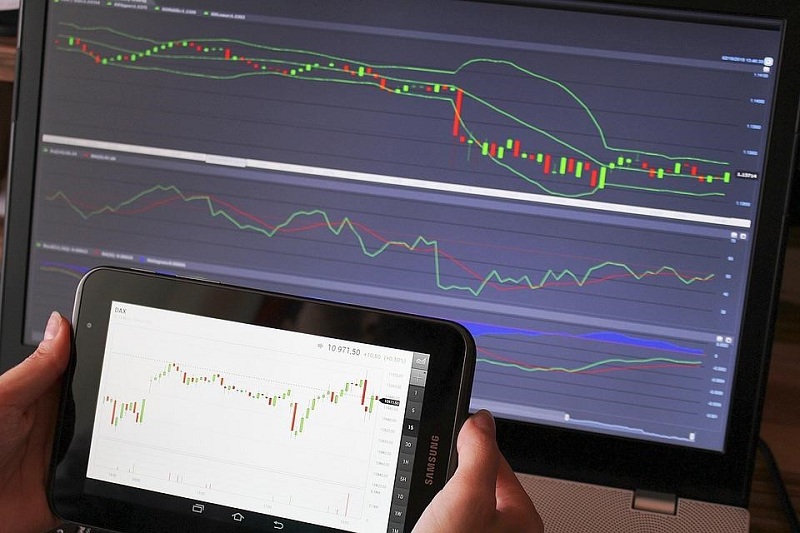Unlocking Crypto Success: Mastering Charting Tools for Smart Investing
Diving into the world of crypto can spark both awe and anxiety. It’s thrilling yet packed with twists and turns. But hold tight—knowing how to use crypto charting tools makes a world of difference. Think of it like having a superpower. You see patterns, catch trends, and call shots with confidence. Let’s cut through the jargon and get to the point. We’ll start with charting basics, spot crucial support and resistance levels, and go all-in on the technical indicators that can make or break your game. Ready to play the market like a pro? Stick with me, and let’s turn those confusing lines and numbers into a clear path to crypto victory.
The Fundamentals of Crypto Charting Tools
Understanding Crypto Charting Basics
Did you ever play connect the dots? Crypto charting is similar. It’s you drawing lines to see where your money could go next. Think of a chart as a map. It tells you where your crypto has been and hints at where it could go. Crypto charts show price changes over time. They look like hills and valleys. The price is on the y-axis (that’s the side one). Time is on the x-axis (the bottom one).
Let’s dig into candlesticks—they aren’t just for fancy dinners. Each candlestick on a chart shows four key prices: open, close, high, and low, during a specific time. They are like mini stories. Green means prices went up. Red means they went down. They help you spot trends. If you see a lot of green, you’re on a likely uptrend. A bunch of red? That can mean a downtrend.
Next up are volume bars. They show how many coins were traded in a time frame. More volume can mean a stronger price move. Few trades might mean little faith in the price. Think of it like cheering at a sports game. Louder cheers can mean a better play.
We also have moving averages. They smooth out price data. They help you see if a trend is starting or ending. If the price is above the moving average, things might be looking up. Below it could signal trouble.
Remember, reading charts takes practice. Start with the basics. From there, move to the tricky stuff.
Identifying Key Support and Resistance Levels
Support and resistance levels are like floors and ceilings in crypto prices. Imagine you’re in a room tossing a ball. The floor is support—where the ball bounces from. The ceiling is resistance—where the ball hits.
Support is the price level where buying is strong enough to stop the price from dropping further. It’s where people think, “Hey, this is cheap! I should buy!” Resistance is where selling is strong, stopping the price from climbing higher. It’s like people saying, “This is pricey, I might sell now.”
Finding these levels helps you make smart choices. For support, look for a price where the coin keeps bouncing back up. For resistance, find where it keeps getting pushed down. You can draw lines on your chart to mark them. These lines guide you. They help you decide when to buy or sell.
Charts are full of patterns. Some look like triangles or flags. They hint at prices going up or down. Spotting these early can mean making a smart trade.
To get the hang of all this, practice with free charting software for digital currency. Look for patterns and play around with indicators. The more you practice, the better you get.
Start simple and build up your skills. With time, you’ll be reading charts like a pro. Use these tools to help guide your crypto journey. You might just find yourself making smarter, more confident trades.

Technical Indicators: The Building Blocks of Smart Investing
Moving Averages and Bollinger Bands: Decoding Market Direction
Let’s talk about moving averages first. They are like a magic wand for seeing market trends. When prices go up, the moving average line slopes up too. If prices drop, the line goes down. Simple, right? By using moving averages, you can spot a trend’s direction fast.
Now, Bollinger Bands. Think of them as rubber bands wrapped around price bars on a chart. They squeeze close when the market is quiet and stretch wide when prices move a lot. You can tell if the market might start to swing by how tight those bands are.
Combining these two tools, you begin to see where prices might head next. If prices are above the moving average and pushing the upper Bollinger Band, the market could be climbing. If they are under the moving average and hitting the lower Band, a drop might be coming.
MACD and RSI: Gauging Market Momentum and Sentiment
MACD stands for Moving Average Convergence Divergence. It’s a fancy name for a tool that shows you if a trend is strong or weak. It does this by drawing two lines based on past prices. When they cross, it can signal a new trend starting.
RSI, or Relative Strength Index, tells you if a crypto is bought or sold too much. This tool has a scale from 0 to 100. A score over 70 means a crypto might be overbought, and under 30 means it could be oversold. This can clue you in on a potential reversal of prices.
These tools—MACD and RSI—are like fuel gauges for your crypto car. They help you feel the market’s momentum. When deciding when to buy or sell, checking these gauges can help a lot.
When you blend these tools—the moving averages for trend directions, Bollinger Bands for market noise, MACD for trend strength, and RSI for buying or selling pressure—you get a clearer picture. You start to read crypto charts like a pro and make smarter choices. No random guessing, just smart strategy.
Practice these tools often. With time, you’ll get better at spotting trends and making trades that win more than lose. Remember, the key is not in winning every time, but in winning enough times, and not losing big. That’s what smart investing is all about.

Advanced Techniques in Cryptocurrency Charting
Utilizing Fibonacci Retracement for Precision Trading
Ever tried drawing a line between two points on a chart? That’s what we do in crypto, but with a twist. We use something called Fibonacci retracement. You might think, “Sounds fancy, must be tough.” But trust me, with a bit of practice, you’ll use it like a pro to spot price levels.
So, what is this Fibonacci thing? It’s a tool, with lines at certain percentages. Each line is a spot where the price might stop and reverse. It’s like a roadmap for prices. When you draw it from high to low on a chart, you see where support and resistance could be. If prices dip, they might bounce back at one of these lines.
Using Fibonacci retracement can make a big difference. With it, you know where to enter or exit trades. You’ll see spots where the price could change course. It’s about getting in and out with more coins in your pocket. Just remember, it’s not magic. It works a lot, but not always, so stay sharp!
Interpreting Crypto Candlestick Patterns and Volume Analysis
Another trick up our sleeves is candlestick patterns. Each candle tells a story of the fight between buyers and sellers. A green one means buyers won that round; a red one means sellers did. The patterns they make as a team can hint at what comes next. You’ll see patterns like ‘head and shoulders’ or ‘cup with handle.’ These names may sound like they belong to a gym, but in trading, they’re pure gold.
Each share or coin has a story, and volume tells it. Volume is like the loudness of that story. More volume means a stronger price move. It’s like more people shouting ‘This is where it’s at!’ This can signal that a price jump could stick, or that a fall won’t last. Low volume, though, might mean a move won’t hold.
Combining candlesticks with volume analysis is like chocolate and peanut butter – better together. If you see a pattern you like, check the volume. It should agree with the pattern for a stronger hint at what’s next.
Remember, charts don’t predict the future. They’re just tools to help you guess better. Like good detectives, we look for clues in the patterns and volume. We make better bets on where prices might head next. It’s not surefire but think of it as upping your game. You make choices based on solid clues, not just gut feels.
So, there you go, using Fibonacci and candlestick patterns with volume can up your trading game. Keep practicing, and soon you’ll read charts with confidence, making smart moves on your trades.

Developing a Robust Crypto Trading Strategy
Integration of Technical Analysis Tools for Trade Optimization
When you trade crypto, you need to make smart moves. Think of technical analysis tools as your secret weapon. They reveal what’s cooking in the market. Start with reading crypto charts. They plot prices and movement over time.
For example, moving averages smooth out price action. They show if a coin’s value is flying high or diving deep over a period. But here’s the kicker: when a short-term moving average crosses a longer one, it could be your ‘buy’ or ‘sell’ hint. This is called a MA crossover and is one of the popular technical indicators for crypto.
Another helper is Bollinger bands. They may sound fancy, but they’re just lines. These lines form a price sandwich, showing if a coin is over or under its average value. If prices hug the top line, get ready. They might drop soon. And if they stick to the bottom? Prices might bounce back up.
Volume analysis steps in here like a best friend. It adds weight to chart tools. It tells you how many people are buying or selling. A big move on thin volume might be a head fake. Don’t fall for it. But if volume’s heavy, the price action is legit.
Next up, the MACD indicator. It’s like a trend detective. It hunts down trend changes before they’re obvious. You see two lines: when the fast one crosses the slower line, pay attention. It’s trade time.
RSI, or Relative Strength Index, checks if a coin is a hot buy or past its prime. Stuck above 70? Maybe it’s too popular, and a sell-off could come. Below 30? It might be undervalued and ready to climb.
Crypto charting platforms bring all these tools to your screen. Use them for making your own crypto trading strategies.
Risk Management: Setting Up Stop Loss and Identifying Breakouts
Now, let’s talk safety — risk management. Each trade carries risk. But you can wear a financial seatbelt: the stop loss. Place a stop loss order to sell your coin if its price dips too much. This way, you limit your potential losses.
Identify breakouts to spot a rally early. A breakout happens when prices bust through resistance or bounce from support levels with gusto. These levels are like floors and ceilings for prices. If coins crack these levels, big moves may follow.
Understanding bullish and bearish signals helps too. Bullish? Expect prices to rise. Bearish? They might fall. Spot these signals early and act.
Peek at patterns in the charts. They hint at future moves. Head and shoulders, triangles, flags — they’re the cryptic clues in your crypto detective work.
In short, use your charting tools. They’re your map and compass in the wild crypto world. They guide you to trade smart and protect your coins.
Remember, the market waits for no one. Keep learning, keep practicing. And who knows? You might just unlock the treasure chest of crypto success.
In this post, we dove deep into crypto charting. We started with the basics, explaining how to read charts and find major support and resistance levels. Then we moved on to technical indicators like moving averages, Bollinger Bands, MACD, and RSI to spot market trends and moods.
Next, we tackled advanced charting techniques. We talked about using Fibonacci retracement for precise trades and how to read candlestick patterns and volume. Lastly, we showed how to build a strong trading plan by combining these tools and managing risk with stop loss and breakout strategies.
My final thoughts? Charting is a must for smart crypto investing. It’s not just about the tools—it’s how you use them to make informed decisions. Use what you’ve learned here to trade better and stay ahead in the fast-moving crypto market. Remember, always do your research and never risk more than you can afford to lose. Happy trading!
Q&A :
What are crypto charting tools and how do they work?
Crypto charting tools are applications or platforms that provide visual representations of cryptocurrency market data, such as price and volume over time. They often include a variety of technical indicators and drawing tools that traders can use to analyze market trends and make predictions about future price movements. Users can customize charts to their preference, focusing on different time frames or applying specific analytical techniques to inform their trading decisions.
How can beginners start using crypto charting tools effectively?
Beginners should start by familiarizing themselves with the basic features of charting tools such as understanding how to read candlestick patterns, the meaning behind common indicators like moving averages, RSI, and volume, as well as how to use drawing tools to identify support and resistance levels. Learning through tutorials, online courses, and practice on the tools using historical data or demo accounts can be highly beneficial for getting started.
What are the best charting tools for crypto technical analysis?
The best charting tools for crypto technical analysis are subjective and vary based on user needs, but some widely recognized platforms include TradingView, Coinigy, and CryptoCompare. These tools offer extensive charting capabilities, a broad range of indicators, and user-friendly interfaces that cater to both novice and experienced traders. It’s important to choose a tool that offers real-time data and the ability to customize your analysis.
Can you use crypto charting tools on mobile devices?
Yes, many crypto charting tools are available on mobile devices, either through mobile-responsive websites or dedicated applications. This allows traders to monitor the markets and perform technical analysis on-the-go. However, the smaller screen size might limit the experience, so it’s often recommended to conduct more detailed analysis on a desktop for better visibility and easier manipulation of the charts.
How important is it to use multiple time-frames in crypto charting tools?
Using multiple time-frames in crypto charting tools is crucial for a more comprehensive analysis. Different time-frames can provide varying perspectives on the market; for example, short-term time-frames can capture more granular price movements, while longer time-frames can help identify broader trends and patterns. By comparing these, traders can make more informed decisions and potentially identify trade setups that align with both short-term and long-term views.



